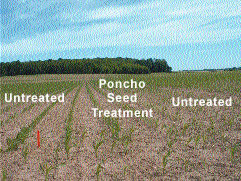
Emerging Insect Pests in Corn
Dr. Art Schaafsma, Dr. David Hooker, Sigrun Kullik,
Ridgetown College, University of Guelph
 Corn
rootworm
Corn
rootworm
Because of good crop rotation practices, corn rootworm is generally a
minor concern in Ontario. Corn rootworm still causes localized problems
where crop rotations may not be possible, such as on dairy farms. Normally,
adult rootworm beetles deposit their eggs in corn. In the following spring,
these eggs then hatch into larvae that feed on the roots of corn planted
after corn. In Illinois and Indiana, a new strain of corn rootworm that
lays eggs in other crops has become a significant problem in first-year
corn since the late 1980s. It was discovered that rootworm beetles preferred
to deposit eggs in soybean fields rather than in corn; the eggs then hatched
the following year in corn planted after soybeans. This new type of the
corn rootworm has spread eastward from Indiana, and by 1996, confirmed
cases were reported in western Ohio.
Some counties in southern Michigan are now also finding this new variant.
Consequently, millions of hectares in these regions require insecticide
treatment for corn following soybeans.
Although we found some rootworm egg-laying in soybean and wheat fields
between 1998 and 2001 in Ontario, the populations have been insignificant
to date. We have been monitoring the situation each year and so far there
is no evidence that this problem has reached Ontario. We have found genetic
differences between normal adults and the soybean-adapted type collected
in the U.S. We believe that the soybean-adapted rootworm may not pose
an economic threat in Ontario because of higher diversity in both crop
rotations and the landscape compared to that in the U.S. We are spearheading
a regional project with Michigan, Ohio, Indiana and Illinois to test this
question. With funding from CanAdapt, Ontario Corn Producers and other
groups, we are seeking to develop methods to quickly identify the variant
type of rootworm using genetics, and to identify conditions that lead
to the development and spread of the soybean-adapted variant; this knowledge
would be useful for assessing the potential for adaptation under Ontario
conditions.
European
chafer
European chafer is a new white grub that has threatened both corn and
wheat on about 8000 hectares in Ontario each year since 2000. Chafers
are most prevalent on sandy knolls, and are a new problem in wheat and
corn, apparently spilling over from the turf industry. In turf, chafer
white grubs have been with us for over twenty years. Management opportunities
for controlling the pest include tillage before planting corn, delaying
corn planting until the grubs become less active, or planting soybeans
instead of corn. All of these management options, however, conflict with
measures to control soil erosion and to maintain a proper crop rotation.
Control is often unsatisfactory with existing insecticides. The new seed
treatment, Poncho, is showing some promise, but is currently not available.
Our preliminary data show that damage from chafers in corn may be minimal
with populations of less than four chafers per square foot. Field surveys
showed chafer populations are associated with soil texture and topography;
chafer populations should be assessed on sandy knolls in a field.
 Black
cutworm
Black
cutworm
Black cutworm is a sporadic pest of corn; corn stands have been reduced
by up to 90% in severe infestations. The first generation of moths migrate
into Ontario from the U.S. in early spring; they are attracted to fields
with heavy residue and green weed cover.
Recently registered Herculex I corn hybrids provide moderate to high levels
of protection against black cutworm. These hybrids express the Bt protein
CRY 1F. In general, rescue treatments for controlling cutworm may be warranted
when 3-5% of corn seedlings at the 2-leaf to 4-leaf stage have been cut
below the ground. However, this threshold was developed with hybrids lacking
resistance against cutworm; it is not clear whether rescue treatments
are warranted with Herculex I hybrids. We are also finding some activity
against black cutworm with Poncho seed treatment (see Figure 2), and are
planning to look at how the Herculex I and Poncho might complement each
other.
Poncho
Seed Treatment for Corn
Registration is expected in March 2003 for a seed treatment from Gustafson
called Poncho – a suitable replacement for diazinon and lindane.
Poncho will be available only for commercial application, so we are expecting
that seed corn may be ordered this fall in time for the 2004 crop year.
We studied the effectiveness of Poncho in commercial-scale strip trials
across farm fields. Over 40 farm fields were targeted for the trials across
southern Ontario; fields were chosen with expectations of high populations
of either black cutworm, wireworm, European chafer or corn rootworm. In
general, the low rate of Poncho was sufficient to provide excellent control
of wireworm (see Figure 1), while the high rate provided excellent protection
against corn rootworm.
Other research has noted that seed treatments containing diazinon and
lindane were only 50% to 60% effective against wireworm; our results suggest
that Poncho consistently provides between 80% and 90% control of wireworm.
Based on our small-plot studies, we expect similar results against European
chafer and black cutworm (see Figure 2) with Poncho; high infestations
of these pests did not develop in our on-farm trials in 2002. Poncho also
provides protection against seed corn maggot and corn flea beetle.